|
|
|
Sort Order |
|
|
|
Items / Page
|
|
|
|
|
|
|
| Srl | Item |
| 1 |
ID:
187496


|
|
|
|
|
| Summary/Abstract |
Arms control has increasingly become threatened by compliance issues. Viewed individually, these issues might be expected and should not be cause for alarm. However, the list of agreements with unresolved issues has grown too long to ignore. The US State Department’s 2021 arms-control-compliance report calls attention to this problem. Recent casualties include the 1987 Intermediate-Range Nuclear Forces Treaty, the 1990 Conventional Armed Forces in Europe Treaty, and the 1992 Open Skies Treaty. Although the 2010 New Strategic Arms Reduction Treaty has been renewed, even the 1968 Treaty on the Non-Proliferation of Nuclear Weapons is under stress because of the view, shared by many states, that there has been a failure to implement its key nuclear-disarmament obligation. Many are advocating a move to less formal arms-control arrangements that are politically but not legally binding. However, these bring their own set of compliance problems—in particular, lack of effective verification regimes and dispute-resolution mechanisms. The current approach to compliance issues is failing. These issues need more urgent, high-level attention if the world is to avoid this threat to international peace and security.
|
|
|
|
|
|
|
|
|
|
|
|
|
|
|
|
| 2 |
ID:
187497


|
|
|
|
|
| Summary/Abstract |
Nonproliferation systems comprise agreements designed to work in concert to manage specific security risks. New technologies, however, are exacerbating these risks by perforating controls and evading regulations while revealing limitations in the utility of these tools for managing threats from emerging dual-use technologies. This article first looks at how regime augmentation and control-list modernization have worked as solutions to past challenges for nonproliferation systems. Second, it argues that new drivers of this risk are creating near-unmanageable conditions. These drivers include the increased rate of production of novel technologies; the digital format of newer technologies, as well as the digitization of existing weapons technologies, platforms, and systems; and the diffusion and latency these drivers facilitate. Finally, the article assesses the feasibility of control-list modernization as a solution to risks posed by rapidly emerging and evolving dual-use technologies today. It argues that nonproliferation efforts should endeavor to preserve the control systems currently in place while simultaneously pursuing complementary measures to mitigate the effects of the digital diffusion of dual-use technologies.
|
|
|
|
|
|
|
|
|
|
|
|
|
|
|
|
| 3 |
ID:
187488
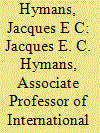

|
|
|
| 4 |
ID:
187487


|
|
|
| 5 |
ID:
187489


|
|
|
| 6 |
ID:
187490


|
|
|
| 7 |
ID:
187494


|
|
|
|
|
| Summary/Abstract |
According to Nina Tannenwald, the nuclear taboo is a deeply held moral norm against the first use of nuclear weapons. If the nuclear taboo is violated by a country engaging in nuclear first use, how might the taboo be preserved and nuclear restraint restored? An analysis contrasting the logic of nuclear deterrence with the logic of the nuclear taboo offers reasons why the nuclear taboo cannot be preserved if the response to nuclear first use is nuclear reprisal. Instead, the preservation of the nuclear taboo would require a combination of diplomatic, economic, and conventional military responses. Nuclear reprisal might restore nuclear deterrence, but it would also validate the role of nuclear weapons in national or alliance security policy. Taboo enforcement cannot rely on the very behaviors the taboo prohibits.
|
|
|
|
|
|
|
|
|
|
|
|
|
|
|
|
| 8 |
ID:
187486


|
|
|
| 9 |
ID:
187491


|
|
|
|
|
| Summary/Abstract |
This article identifies the principal drivers of Russian military innovation involving five novel nuclear, conventional, or dual-capable delivery systems—Avangard, Burevestnik, Poseidon, Kinzhal, and Tsirkon—and analyzes the interplay between these drivers over the course of the innovation process. It does so by means of a structured, focused comparison of the five systems and their progression to date, distinguishing “innovation” from concepts like “invention” and “diffusion,” and defining the stages of an innovation life cycle. The article also distills prior research on Soviet weapons innovation and investigates its continued validity. The analysis finds external factors to be central in driving innovation, specifically Russian threat perceptions around (1) US missile-defense development and (2) the development of Western conventional warfighting capabilities. It also discusses the roles of a range of internal factors, including industry and high-level political support for specific systems, the availability of Soviet-legacy research and engineering initiatives, and the appeal of anticipated industrial and ancillary benefits from the development of specific systems. Cooperation between design bureaus and other industry players is also examined, as is the role of status considerations in driving innovation. Finally, the relative importance of individual factors in explaining innovation is shown to differ across the systems. The structured comparison identifies the continued validity of certain aspects of past studies on Soviet military innovation, while also bringing to light new insights about contemporary Russian weapons innovation.
|
|
|
|
|
|
|
|
|
|
|
|
|
|
|
|
| 10 |
ID:
187493
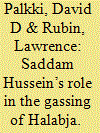

|
|
|
|
|
| Summary/Abstract |
Iraq’s use of chemical weapons against Iraqi Kurdish civilians in 1987 and 1988 is among the most morally troubling events in the latter half of the twentieth century. Most of the questions surrounding the attack, including why, when, and how, have been addressed in path-breaking research by Joost Hiltermann and other researchers from Human Rights Watch. However, even as more records and internal documents from the period have come to light, one question remains unresolved: Did Saddam Hussein, Iraq’s leader, directly order the gassing of Iraqi Kurds? This study reassesses the Halabja attack of 1988—in particular, Saddam’s thinking and behavior relating to the attack—in light of the post-2003 evidence. It synthesizes insights from the Iraqi records at the Conflict Records Research Center and Stanford University; debriefings of Iraqi principals, which the authors obtained in response to Mandatory Declassification Review requests; recent memoirs of Iraqi and US officials; and other previously unexplored sources. Although these records provide no direct proof that Saddam Hussein issued an explicit order to gas Halabja, it is clear he created a command environment in which the indiscriminate gassing of Iraqi Kurds was considered permissible and even desirable.
|
|
|
|
|
|
|
|
|
|
|
|
|
|
|
|
| 11 |
ID:
187492
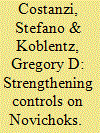

|
|
|
|
|
| Summary/Abstract |
Novichoks, also known as A-series agents, are nerve agents developed in the Soviet Union during the Cold War. Once obscure chemicals, they garnered a great deal of attention after their employment in the attempted assassinations of Sergei and Yulia Skripal in 2018 and of Alexei Navalny in 2020. Novichok agents were not originally featured in the schedules of the Chemical Weapons Convention (CWC), which are intended to support the treaty’s verification regime and declaration requirements. However, following the Skripal incident, the CWC schedules were amended to include Novichok agents. Furthermore, precursors for their synthesis were added to the Australia Group’s (AG) list of chemical-weapons precursors. In this article, we evaluate the recent revisions of the CWC schedules and the AG precursors list, identify the remaining weaknesses of both lists, and make recommendations for further amendments. We recommend strengthening the coverage of the CWC schedules by adding families of Novichok agents with guanidine branches. This is particularly important in light of the Navalny incident, since that incident appears to have involved a guanidine-bearing Novichok agent currently not covered by the CWC schedules. We also propose an approach to the control of Novichok precursors by the CWC and the AG based on families of chemicals rather than individually enumerated chemicals.
|
|
|
|
|
|
|
|
|
|
|
|
|
|
|
|
| 12 |
ID:
187485
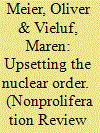

|
|
|
|
|
| Summary/Abstract |
Nationalist populists as leaders of states that possess nuclear weapons undermine the nuclear order and increase nuclear dangers in novel, significant, and persistent ways. Such leaders talk differently about nuclear weapons; they can put nuclear policy making and crisis management in disarray; and they can weaken international alliances and multilateral nuclear institutions. The rise of nationalist populists in nuclear-armed states, including some of the five nuclear-weapon states recognized under the 1968 Treaty on the Nonproliferation of Nuclear Weapons, shatters the presumed distinction between responsible and irresponsible nuclear powers and complicates attempts to heal rifts in the international order. Policies to wait out populists or to balance their influence in multilateral institutions seem to have had limited success. A sustainable strategy to deal with the challenge posed by populists would need to start by recognizing that we can no longer assume that nuclear weapons are safe in the hands of some states but not in others’.
|
|
|
|
|
|
|
|
|
|
|
|
|
|
|
|
| 13 |
ID:
187495
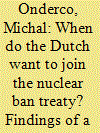

|
|
|
|
|
| Summary/Abstract |
Even if most European countries have not yet joined the Treaty on the Prohibition of Nuclear Weapons (TPNW), the treaty has been salient in a number of national settings. In the Netherlands, the TPNW enjoys broad societal appeal, and the Dutch parliament has, on a number of occasions, called on the government to explore options for joining the treaty. In this piece, we empirically study Dutch attitudes toward joining the TPNW. Our findings indicate that a majority of the Dutch would prefer to accede to the TPNW only if nuclear-weapon states or other NATO allies also joined, although unilateral accession received relatively strong support among the youngest respondents, women, and voters supporting the left-wing parties. The most popular option is to join the TPNW at the same time that the nuclear-weapon states do, which seems to be a rather distant prospect in the current international-security environment.
|
|
|
|
|
|
|
|
|
|
|
|
|
|
|
|
|
|
|
|
|